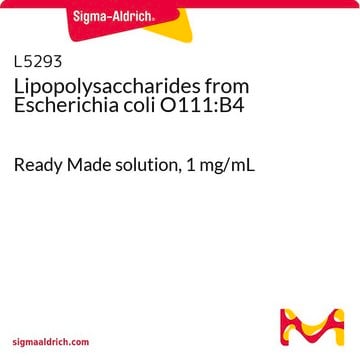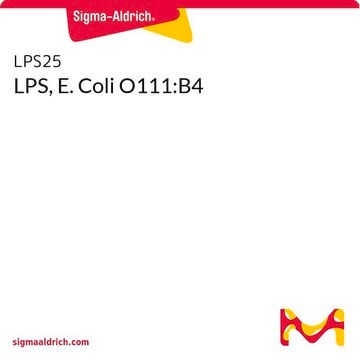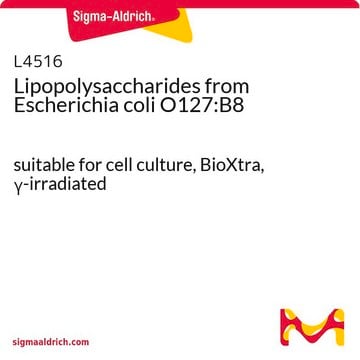Significant lot-to-lot variability in potency is quite normal for this product. It is a somewhat crude phenol extract; it is not chromatographically purified. That is, a chromatographically purified LPS such as Product L3012 would be expected to have better lot-to-lot consistency. Note that for both this product and L3012, the potency specification is greater than or equal to 500,000 Endotoxin units per milligram (EU/mg); there is a lower limit, but there is no upper limit.
L2630
Lipopolysaccharides from Escherichia coli O111:B4
purified by phenol extraction
Synonim(y):
LPS
Wybierz wielkość
381,00 zł
Wybierz wielkość
About This Item
381,00 zł
Polecane produkty
pochodzenie biologiczne
Escherichia coli (O111:B4)
Poziom jakości
Formularz
lyophilized powder
oczyszczone przez
phenol extraction
metody
ELISA: suitable
cell based assay: suitable
ligand binding assay: suitable
zanieczyszczenia
≤3.00% protein (Lowry-TCA)
kolor
off-white to faint yellow
rozpuszczalność
water: soluble
Zastosowanie
cell analysis
clinical research
life science and biopharma
Warunki transportu
ambient
temp. przechowywania
2-8°C
Szukasz podobnych produktów? Odwiedź Przewodnik dotyczący porównywania produktów
Opis ogólny
This product is phenol extracted from Escherichia coli serotype O111:B4. The source strain is from a private collection. This LPS serotype has been used to stimulate B-cells and induce NOS (nitric oxide synthase) in human hepatocytes.
Zastosowanie
- for the stimulation of macrophages[4][5]
- for LPS preconditioning in mice[6]
- to induce acute kidney injury in mice[7]
- to induce acute respiratory distress syndrome (ARDS) in mice to study the anti-inflammatory effects of bone marrow mesenchymal stem cell (BMSCs)-derived exosomes[8]
- to induce hyperinflammatory status in severe acute respiratory syndrome coronavirus 2 (SARS-CoV-2) infected mice[9]
Działania biochem./fizjol.
Uwaga dotycząca przygotowania
Inne uwagi
produkt powiązany
Hasło ostrzegawcze
Danger
Zwroty wskazujące rodzaj zagrożenia
Zwroty wskazujące środki ostrożności
Klasyfikacja zagrożeń
Acute Tox. 2 Oral
Kod klasy składowania
6.1A - Combustible acute toxic Cat. 1 and 2 / very toxic hazardous materials
Klasa zagrożenia wodnego (WGK)
WGK 3
Temperatura zapłonu (°F)
Not applicable
Temperatura zapłonu (°C)
Not applicable
Środki ochrony indywidualnej
Eyeshields, Gloves, type N95 (US)
Wybierz jedną z najnowszych wersji:
Certyfikaty analizy (CoA)
Nie widzisz odpowiedniej wersji?
Jeśli potrzebujesz konkretnej wersji, możesz wyszukać konkretny certyfikat według numeru partii lub serii.
Masz już ten produkt?
Dokumenty związane z niedawno zakupionymi produktami zostały zamieszczone w Bibliotece dokumentów.
Klienci oglądali również te produkty
Produkty
Poznaj strukturę, funkcję i różnorodne zastosowania lipopolisacharydów. Odkryj ich rolę w bakteriach, specyficzność serologiczną i potencjał badawczy.
Explore the structure, function, and diverse applications of Lipopolysaccharides. Discover their role in bacteria, serological specificity, and research potential.
-
When I compared COAs of two batches of LPS (L2630) we have been using, I realized the potency of the newer one is 10-fold higher than the older one (30000000 and 3000000 EU/mg). Is it common for LPS that different lots have such different potency?
1 answer-
Helpful?
-
-
How can I determine the shelf life / expiration / retest date of this product?
1 answer-
If this product has an expiration or retest date, it will be shown on the Certificate of Analysis (COA, CofA). If there is no retest or expiration date listed on the product's COA, we do not have suitable stability data to determine a shelf life. For these products, the only date on the COA will be the release date; a retest, expiration, or use-by-date will not be displayed.
For all products, we recommend handling per defined conditions as printed in our product literature and website product descriptions. We recommend that products should be routinely inspected by customers to ensure they perform as expected.
For products without retest or expiration dates, our standard warranty of 1 year from the date of shipment is applicable.
For more information, please refer to the Product Dating Information document: https://www.sigmaaldrich.com/deepweb/assets/sigmaaldrich/marketing/global/documents/449/386/product-dating-information-mk.pdfHelpful?
-
-
How is shipping temperature determined? And how is it related to the product storage temperature?
1 answer-
Products may be shipped at a different temperature than the recommended long-term storage temperature. If the product quality is sensitive to short-term exposure to conditions other than the recommended long-term storage, it will be shipped on wet or dry-ice. If the product quality is NOT affected by short-term exposure to conditions other than the recommended long-term storage, it will be shipped at ambient temperature. As shipping routes are configured for minimum transit times, shipping at ambient temperature helps control shipping costs for our customers. For more information, please refer to the Storage and Transport Conditions document: https://www.sigmaaldrich.com/deepweb/assets/sigmaaldrich/marketing/global/documents/316/622/storage-transport-conditions-mk.pdf
Helpful?
-
-
Is there any harm in filter sterilizing a solution with this LPS before using it in cell culture or animals? Meaning does it change or lose potency if it is sterile filtered say through a 0.2 micron filter?
1 answer-
Sterile filtration should not affect the concentration or properties of the solution if the LPS is fully dissolved, but please keep in mind that this is a research-grade material that has not been best tested on animals. For a cell culture grade material that has already been γ-irradiated, please consider the following: https://www.sigmaaldrich.com/product/sigma/l4391
Helpful?
-
-
I received LPS L2630 at Room Temperature. Is it ok to keep it at Room Temperature before reconstitution, although recommendations are to store it between 2-8 C?
1 answer-
This product ships routinely at ambient temperature and is stable up to 2 weeks to allow for transit time. The item is to be stored at 2-8°C when received.
Please see the link below to review the product storage and shipping guidelines:
https://www.sigmaaldrich.com/deepweb/assets/sigmaaldrich/marketing/global/documents/232/426/storage-transport-conditions-ms.pdfHelpful?
-
-
Is product L2630 suitable for use in mammalian cell culture?
1 answer-
Specific testing or validation for the use of product L2630 in mammalian cell culture has not been conducted.
Helpful?
-
-
Hi i recieved L2630 10mg Lipopolysaccharides from Escherichia coli O111:B4 i will used in experimental work. how i will dilute it
1 answer-
The product is soluble in water (5 mg/mL) or cell culture medium (1 mg/mL). Please see the link below to review additional preparation and storage information:
https://www.sigmaaldrich.com/US/en/technical-documents/protocol/clinical-testing-and-diagnostics-manufacturing/bacteriology/lipopolysaccharidesHelpful?
-
-
What is the purity level of this product ? is it ultrapure? 100% pure LPS ?
1 answer-
This product is not tested for purity. However, it is tested for potency on a lot-specific basis.
Kindly review a sample CoA accessible at this link: https://www.sigmaaldrich.com/certificates/sapfs/PROD/sap/certificate_pdfs/COFA/Q14/L2630-VAR0000271356.pdf
Helpful?
-
-
Once a solution is developed by dissolving product Lipopolysaccharides from Escherichia coli O111:B4 in water, what is the storage protocol and and how long will it remain usable?
1 answer-
Please see the following link describing our LPS products: https://www.sigmaaldrich.com/technical-documents/protocol/clinical-testing-and-diagnostics-manufacturing/bacteriology/lipopolysaccharides
STORAGE/STABILITY
Solutions at 1 mg/mL in buffer or culture medium are stable for approximately one month at 2-8 °C. Frozen aliquots can be stored up to 2 years. Repeated freeze/thaw cycles are not recommended. Solutions should be stored in silanized containers, since LPS can bind to plastics and certain types of glass (especially at concentrations of <0.1 mg/mL). If the LPS concentration is >1 mg/mL, adsorption to the sides of the vial is negligible. If glass containers are used, solutions should be vortexed for at least 30 minutes to redissolve the adsorbed product.Helpful?
-
-
How concentrated a stock solution can I make of Product L2630, Lipopolysaccarides (LPS)?
1 answer-
One can try to make a 20 mg/mL solution at 70-80°C in saline, with vortexing and warming. However, the solution will be hazy, because of the nature of LPS to form micelles in solutions like water or PBS.
Helpful?
-
Active Filters
Nasz zespół naukowców ma doświadczenie we wszystkich obszarach badań, w tym w naukach przyrodniczych, materiałoznawstwie, syntezie chemicznej, chromatografii, analityce i wielu innych dziedzinach.
Skontaktuj się z zespołem ds. pomocy technicznej





